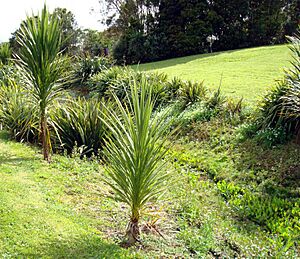Meola Creek facts for kids
Meola Creek is a stream in Auckland, New Zealand. It flows through a natural valley that starts near Mount Albert and goes down to the Waitematā Harbour. The area around the creek is busy with homes, shops, and parks. Sadly, the creek is affected by pollution from the city.
The creek flows into a part of the Waitematā Harbour that has been developed for a very long time. This area is naturally a flood plain, but much of it has been turned into parks and sports fields. A lot of the mangrove trees, which are special coastal trees, are still there. Next to Point Chevalier, you can see Te Tokaroa, also known as Meola Reef. This reef is a long lava flow, about 10 kilometers (6 miles) long, that came from the Mount Saint John volcano. The reef itself stretches for over 2 kilometers (1.2 miles) across the Waitematā Harbour.
Contents
History of Meola Creek
How Meola Creek Got Its Name
Long ago, the local Māori called this stream Waititiko. This name means "water of the periwinkles," which are small sea snails. Later, European settlers arrived and renamed it Meola Creek. Some people think it was named after a glacier in India. This might be because Allan Kerr Taylor, an important early settler, was born near a glacier called Meola Glacier and lived in India until he was eight years old.
Alberton House and the Wetlands
The Kerr Taylor family lived close to where Meola Creek begins. Their large house, called Alberton, was built with an Indian style. It is now one of New Zealand's most loved historic homes. Before people lived here, much of the area around the creek was wetlands, which are like swamps. In fact, the nearby suburb of Sandringham used to be called Cabbage Tree Swamp until the mid-1800s. After European settlers arrived, the area remained a swampy place covered in gorse plants. It was finally drained and turned into school sports fields in 1953.
The Great Otter Escape
In June 2006, an Asiatic short-clawed otter named Jin made headlines across New Zealand! Jin escaped from Auckland Zoo by swimming down Meola Creek. The tide was going out, so Jin was carried all the way into the Waitematā Harbour. This adventurous otter was later found and caught on Motutapu Island in Auckland's Hauraki Gulf.
Threats to Meola Creek
Pollution Problems
Tests on the water and mud in Meola Creek show that it is not in good health. The way the creek has been changed and the pollution it faces have badly affected the plants and animals living there. Things like heavy metals and chemicals from oil get into the creek through several stormwater drains.
Because the area around the creek has many buildings, roads, and car parks, there are lots of hard surfaces. These surfaces don't let water soak into the ground. Instead, rain washes dirt and pollution directly into the creek. The creek also gets a lot of mud from water draining off school sports fields and from soil washing away due to erosion. When it rains heavily, the pipes that carry both sewage and stormwater sometimes overflow. This means untreated wastewater can flow straight into the creek.
Harmful Metals in the Harbour
The problems aren't just in the creek itself. In the area where Meola Creek flows into the Waitematā Harbour, levels of zinc and lead are too high. This means that the animals living in the mud at the bottom of the harbour, like shellfish, are seriously affected. Heavy metals like zinc can stay in the water and mud for a long time. Because of this, they can build up in the bodies of these bottom-dwelling animals and in the animals that eat them.
Zinc is known to be harmful to water plants and animals. For fish, zinc in the water can make it hard for them to control their body salts, damage their gills, and make it difficult for them to breathe. It's not fully known how much of this pollution comes from old factories. However, we do know that a lot more zinc has entered this part of the harbour since the 1950s. This was when galvanized paint, which contains zinc, started to be used on rooftops in the growing city. Industrial roofs, in particular, have been found to have much higher levels of zinc than other city sources.


